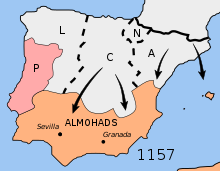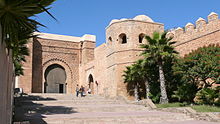Almohads

The Almohads (from Arabic الموحدون al-muwahhidun , DMG al-muwaḥḥidūn 'Confessor of the oneness of God '; Tifinagh script ⵉⵎⵡⴻⵃⵃⴷⴻⵏ ) were a Muslim Berber dynasty thatruledthe Maghreb and al-Andalus between 1147 and 1269.
history
The Almohad dynasty was founded by Ibn Tumart in 1121, who evangelized the Masmuda Berbers of the High Atlas for his theology . The latter saw only the Koran and the tradition of the Prophet as legitimate sources and refused to update the decisions of earlier authorities. She understood the Koran in such a way that the knowledge of the existence and unity of God out of creation can be based on purely rational considerations and opposed the literalistic interpretation of anthropomorphic descriptions of God in the Koran. Incidentally, it was associated with a strict moralism.
In 1129 a first attack on Marrakech failed , but Tumart's successor Abd al-Mumin (r. 1130–1163) led the movement to success and overthrew the Almoravid dynasty with the conquest of al-Andalus in 1148 and Marrakech in 1149. After securing rule over Morocco , the Almohads conquered the Hammadid Empire in Algeria (1152) and the Zirid Empire in what is now Tunisia (1155–1160), thus ruling the entire west of the Islamic world. With the resettlement of Arab Bedouin tribes from Ifrīqiya and Tripolitania to Morocco, the Arabization of the Berbers was also considerably accelerated in this part of the Maghreb.
Under Caliph Abu Yaqub Yusuf I (r. 1163–1184) the empire was further consolidated and defended against the Christian empires, especially in al-Andalus. The Almohads continued the architectural style for mosques created by the Abbasids , which is characterized by the T-disposition from the emphasized central nave and the transept in front of the qibla wall . Examples are the Kutubiyya Mosque in Marrakech and the Tinmal Mosque in the Atlas Mountains . Abu Yaqub Yusuf I and his son Yaʿqūb al-Mansūr were open-minded towards the sciences and promoted, among other things, the philosophical activities of Averroes , even if Yaʿqūb al-Mansūr Averroes, probably out of temporary political interests, moved to Lucena, near Cordoba, for two years in 1197, banished and allowed his ideological opponents to burn his writings.
In Ifriqiya, the Almohads waged a protracted guerrilla war against the Almoravids, which ruined the economy in the eastern and central Maghreb. Nevertheless, under Yaʿqūb al-Mansūr (reigned 1184–1199) in al-Andalus, the advances of Castile in the battle of Alarcos (1195) were repulsed.
In the following years, some provinces gained autonomy under Caliph Muhammad an-Nasir (r. 1199–1213). In al-Andalus, in the wake of the catastrophic defeat of the young caliph in the battle of Las Navas de Tolosa in the summer of 1212 against the unified Christian kingdoms , the Almohad rule was initially not significantly shaken, but weakened in the long term, and was lost in the following decades. When Yusuf II. Al-Mustansir (ruled 1213-1224) came to power as a minor and disputes broke out among the tribal leaders of the Almohads, the decline of the empire began. In the widening anarchy, the Arab Bedouins gained in importance. By 1235, the Almohads had lost control of al-Andalus to Ibn Hud , Ifrīqiya to the Hafsids and Algeria to the Abdalwadids .
In Morocco the Merinids (Banu Marin) began to expand their power in order to establish a new dynasty after the conquest of Fez (1248). Although the Almohads were able to hold their own against the Merinids in Marrakech until 1269, they had largely lost their importance since the fall of Fez.
meaning
The rule of the Almohads was characterized by an increasing balance between Arab and Berber population groups in the countryside. During the decline, however, the nomadic tribes prevailed over the settled population as the most important political force in the Maghreb. This later contributed significantly to the region's economic decline.
Ruler
- Abd al-Moomin (1130–1163)
- Abu Yaqub Yusuf I (1163-1184)
- Yaʿqūb al-Mansūr (1184–1199)
- Muhammad an-Nasir (1199-1213)
- Yusuf II. Al-Mustansir (1213-1224)
- Abd al-Wahid al-Makhlu (1224)
- Abdallah al-Adil (1224-1227)
- Idris I al-Mamun (1227-1232)
- Abd al-Wahid II ar-Rashid (1232-1242)
- Ali Abul-Hasan as-Said (1242-1248)
- Umar al-Mustafiq (1248-1266)
- Abu Dabis (1266-1269)
buildings
In their heyday (approx. 1140–1248), the Almohad rulers erected a large number of imposing religious and secular buildings in Morocco and al-Andalus - also as a token of their claim to power:
Mosques and minarets
- Great Mosque of Taza
- Tinmal Mosque
- Koutoubia Mosque (Marrakech)
- Giralda (Seville)
- Al-Mansur mosque (Marrakech)
- Hassan Tower (Rabat)
- two minarets in Tît (today Moulay Abdallah near El Jadida )
- Akka mosque and minaret
Gates and fortifications
- Bab des Oudaïas (Rabat)
- Bab er Rouah ( Rabat )
- Bab Agnaou (Marrakech)
- Torre del Oro (Seville)
- Torre de Espantaperrus ( Badajoz )
- Taza city walls
- City wall of Tit (near El Jadida )
- City walls of Rabat
The city walls of Fez, Marrakech and Seville, which were built under the Almoravids, have been restored and reinforced.
literature
- Arnold Betten: Morocco - Antiquity, Berber Traditions and Islam. History, art and culture in the Maghreb. DuMont, Ostfildern 2012, ISBN 978-3-7701-3935-4
- Ulrich Haarmann : History of the Arab World . CH Beck, Munich 2001, ISBN 3-406-38113-8 .
- Hans-Rudolf Singer : Almohads . In: Lexicon of the Middle Ages (LexMA). Volume 1, Artemis & Winkler, Munich / Zurich 1980, ISBN 3-7608-8901-8 , Sp. 447-449.
- Literature about the Almohads in the catalog of the Ibero-American Institute in Berlin




